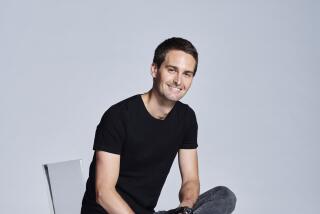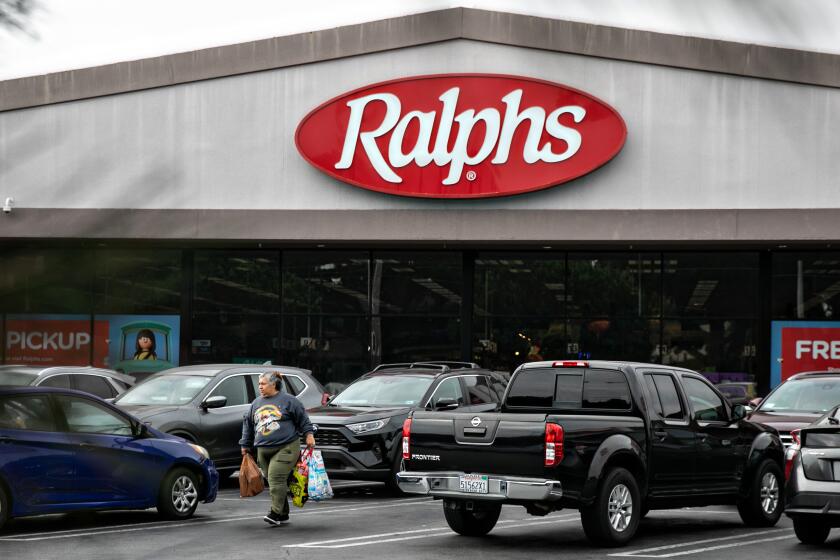How Instagram founder Kevin Systrom became insta-rich
- Share via
SAN FRANCISCO — How does a 28-year-old make $400 million in 18 months?
With the right idea at the right time in mobile apps for smartphones.
Kevin Systrom won the start-up sweepstakes this week when Facebook Inc. said it would pay $1 billion in cash and stock for his photo-sharing app maker, which has a loyal following of 30 million users but never made a dime.
Facebook Chief Executive Mark Zuckerberg called Systrom to personally negotiate the deal for the social media giant, which is expected to fetch a valuation of $100 billion as soon as next month when it begins selling shares to the public. Zuckerberg promised Systrom that Instagram, which has just 13 employees, could operate as an independent company.
It was an unusual concession, but it was also the third time that Zuckerberg had tried to woo Systrom. The first time they crossed paths was in 2004, when Systrom was a Stanford undergrad building a photo-sharing service. Facebook was working on its own photo-sharing feature and asked Systrom to join the company. Systrom wrestled with the decision but turned down the job offer.
Years later, when Instagram caught fire as a free photo-sharing app on mobile devices, Facebook tried to buy the company. Again, Systrom said no.
Systrom, who owns 40% of Instagram and serves as its chief executive, declined to comment Tuesday, citing the quiet period leading up to Facebook’s initial public stock offering.
In an interview with The Times last year, Systrom said he was determined to create a “social tool for social life on the go.” He never once doubted that he was building a $1-billion company that could withstand scorching competition from Facebook and others.
“We want to change the way people communicate and share in the real world,” Systrom said.
Though still in its infancy, Instagram already posed a competitive threat to Facebook, whose future depends on getting people to share more — and look at more ads — on their smartphones. Analysts said Facebook couldn’t pass up the chance to buy Instagram.
On Friday, Instagram closed a $50-million funding round led by Sequoia Capital, which valued the company at $500 million. On Monday, Facebook announced its deal to buy the San Francisco company for twice that amount, doubling Instagram’s value in 72 hours.
It was the biggest acquisition Facebook had ever made, and it made Systrom instantly rich.
“In Silicon Valley, there’s still too much money chasing too few ideas. If your idea is brilliant and your timing is right, you can become a multimillionaire overnight,” Silicon Valley futurist Paul Saffo said.
Systrom, who is likely to play a major role in Facebook’s push into mobile devices, grew up outside of Boston, playing with computers, developing his own computer games and taking photographs. He got his first digital camera when he went to summer camp and took a Photoshop class.
“It was the coolest thing ever,” he said. “You could mess with photos, change the colors and make cool stuff.”
He enrolled at Stanford. He still thought of photography as a hobby, even after he was approached by Zuckerberg and Adam D’Angelo, then Facebook’s chief technology officer.
Systrom took part in Stanford’s Mayfield Fellows Program, a nine-month course for future entrepreneurs. As part of the program, he took a summer internship at podcasting start-up Odeo with Evan Williams, Biz Stone and Jack Dorsey, who later started Twitter Inc.
“That first day, I decided I wanted to be an entrepreneur,” Systrom said.
His first job after graduating from Stanford in 2006 was at Google Inc. Systrom worked mostly in marketing, but he yearned to design products. He taught himself engineering at Nextstop.com, a start-up he joined with former Google employees.
He began experimenting with a check-in app as a weekend project. Systrom met investors from Baseline Ventures and Andreessen Horowitz at a party and showed them the prototype. They invested $500,000. He started looking for a team and in early 2010 hooked up with fellow Stanford grad Mike Krieger.
They switched gears after noticing the large volume of people posting photos. The new Instagram app let users jazz up the look of photos with filters and share them with their friends.
Instagram took just eight weeks to build. It racked up 25,000 users in 24 hours, 200,000 in the first week and 1 million in less than three months. Systrom credits Instagram’s early success to the community of users who commented on and liked one another’s photos.
“I remember thinking to myself, ‘Instagram is going to be something,’” Systrom said. “We hadn’t seen a product resonate and get people so excited so quickly. I knew at that moment we had to put everything behind it.”
Systrom says he lived in fear that Instagram’s wild growth would slow, but it never did. The company had just a handful of employees who worked out of a dark office they dubbed “the cave” in the South Park neighborhood of San Francisco, scrawling ideas for new features on a white board.
In February 2011, Instagram had 1.75 million users posting 290,000 photos a day. It raised $7 million from Benchmark Capital’s Matt Cohler, a former Facebook executive, who led the funding round that also included prominent entrepreneurs such as Twitter’s Dorsey and Quora’s D’Angelo.
In addition to rejecting a buyout offer from Facebook, Systrom also turned down Twitter. He banned meetings with anyone outside the company except for the media and engineering recruits so everyone could focus.
Celebrities such as Justin Bieber flocked to the site. Companies seeking to promote their products, such as Kate Spade, Nike, Red Bull and Starbucks, also climbed aboard.
In August, Instagram hit a major milestone: 150 million photos had been uploaded in the nine months since it had launched. Systrom was giddy. Instagram had not yet figured out how it would make money, but it had figured out how to make its users happy.
“I believe it marks the beginning of what’s to come. We’re one of the fastest-growing social networks in mobile,” he said at the time.
Last week Instagram, which built its product around the iPhone, unveiled its new app for phones running Google’s Android operating system. It has already hit 5 million downloads.
More to Read
Inside the business of entertainment
The Wide Shot brings you news, analysis and insights on everything from streaming wars to production — and what it all means for the future.
You may occasionally receive promotional content from the Los Angeles Times.








